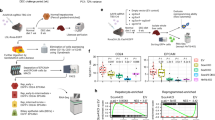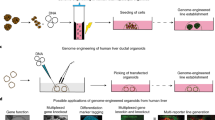Abstract
Prox1 is a transcription factor with two highly conserved domains, a homeobox and a prospero domain. It has been shown that Prox1 knock-out mice die during early embryonic stages and display a rudimentary liver. We have studied the expression of Prox1 at RNA and protein levels in chick, rat, mouse and human liver and in transformed and non-transformed hepatic cell lines. Prox1 is expressed in early embryonic hepatoblasts and is still expressed in adult hepatocytes. Prox1 protein is located in the nuclei of hepatoblasts, which grow into the neighboring embryonic mesenchyme. The expression pattern in chick, mouse, rat and human embryos is highly conserved. Besides albumin and α-fetal protein, Prox1 belongs to the earliest markers of the developing liver. In adult liver, Prox1 is expressed in hepatocytes but is absent from bile duct epithelial and non-parenchymal cells (Kupffer cells, hepatic stellate cells, sinusoidal endothelial cells and myofibroblasts). Isolated primary hepatocytes and hepatoma cell lines (HepG2, Hep3B) are Prox1 positive, whereas the immortalized murine liver cell-line MMH, which constitutively expresses the receptor c-met, is Prox1 negative. Transfection of MMH with Prox1 cDNA increases the expression level significantly as compared to control transfectants. In HepG2 and Hep3B, the Prox1 levels are even up to 100 times higher. Our studies show that Prox1 is a highly conserved transcription factor, expressed in hepatocytes from the earliest stages of development into adulthood and over-expressed in hepatoma cell lines. Its absence from bile duct epithelial cells suggests a function for the specification of hepatoblasts into hepatocytes. The genes controlled by Prox1 need to be studied in the future.








Similar content being viewed by others
References
Aiuti A, Cicchini C, Bernardini S, Fedele G, Amicone L, Fantoni A, Tripodi M (1998) Hematopoietic support and cytokine expression of murine stable hepatocyte cell lines (MMH). Hepatology 28:1645–1654
Amicone L, Galimi MA, Spagnoli FM, Tommasini C, De Luca V, Tripodi M (1997) Transgenic expression in the liver of truncated Met blocks apoptosis and permits immortalization of hepatocytes. EMBO J 16:495–503
Ang SL, Rossant J (1994) HNF-3 beta is essential for node and notochord formation in mouse development. Development 120:2979–2989
Ang SL, Wierda A, Wong D, Stevens KA, Cascio S, Rossant J, Zaret KS (1993) The formation and maintenance of definitive endoderm lineage in the mouse: involvement of HNF3/forkhead proteins. Development 118:139–149
Burke Z, Oliver G (2002) Prox1 is an early specific marker for the developing liver and pancreas in the mammalian foregut endoderm. Mech Dev 118:147–155
Chirgwin JM, Przybyla AE, MacDonald RJ, Rutter WJ (1979) Isolation of biologically active ribonucleic acid from sources enriched in ribonuclease. Biochemistry 18:5294–5299
Cui W, Tomarev SI, Piatigorsky J, Chepelinsky AB, Duncan MK (2004) Mafs, Prox1 and Pax6 can regulate chicken beta B1-cystallin gene expression. J Biol Chem 279(12):11088–11095
De Leeuw AM, Brouwer A, Barelds RJ, Knook DL (1983) Maintenance cultures of Kupffer cells isolated from rats of various ages: ultrastructure, enzyme cytochemistry, and endocytosis Hepatology 3:497–506
De Leeuw AM, McCarthy SP, Geerts A, Knook DL (1984) Purified rat liver fat-storing cells in culture divide and contain collagen. Hepatology 4:392–403
Glasgow E, Tomarev SI (1998) Restricted expression of the homeobox gene Prox 1 in developing zebrafish. Mech Dev 76:175–178
Grompe M, Finegold MJ (eds) (2001) Liver stem cells. In: Stem cell biology. Cold Spring, New York, pp 455–497
Gualdi R, Bossard P, Zheng M, Hamada Y, Coleman JR, Zaret KS (1996) Hepatic specification of the gut endoderm in vitro: cell signalling and transcriptional control. Genes Dev 10:1670–1682
Hamburger V, Hamilton HL (1952) A series of normal stages in development of the chick embryo. J Morphol 88:49–92
Hartmann H, Schmitz F, Christ B, Jungermann K, Creutzfeldt W (1990) Metabolic actions of insulin-like growth factor-I in cultured hepatocytes from adult rats. Hepatology 12:1139–1143
Jung J, Goldfarb M, Zaret KS (1999) Initiation of mammalian liver development from endoderm by fibroblast growth factor. Science 284:1998–2003
Knittel T, Kobold D, Saile B, Grundmann A, Neubauer K, Piscaglia F, Ramadori G (1999) Rat liver myofibroblasts and hepatic stellate cells: different cell populations of the fibroblast lineage with fibrogenic potential. 117:1205–1221
Knook DL, Blansjaar N, Sleyster EC (1977) Isolation and characterization of Kupffer and endothelial cells from the rat liver. Exp Cell Res 109:317–329
Kuo CT, Morrisey EE, Anandappa R, Sigrist K, Lu MM, Parmacek MS, Soudais C, Leiden JM (1997) GATA4 transcription factor is required for ventral morphogenesis and heart tube formation. Genes Dev 11:1048–1060
LeCouter J, Moritz DR, Li B, Phillips GL, Liang XH, Gerber HP, Hillan KJ, Ferrara N (2003) Angiogenesis-independent endothelial protection of liver: role of VEGFR-1. Science 299:890–893
Le Douarin N (1975) An experimental analysis of liver development. Med Biol 53:427–455
Lengler J, Krausz E, Tomarev S, Prescott A, Quinlan RA, Graw J (2001) Antagonistic action of Six3 and Prox1 at the γF-crystallin promoter. Nucleic Acids Res 29:515–526
Neubauer K, Wilfling T, Ritzel A, Ramadori G (2000) Platelet-endothelial cell adhesion molecule-1 gene expression in liver sinusoidal endothelial cells during liver injury and repair. J Hepatol 32:921–932
Oliver G, Sosa-Pineda B, Geisendorf S, Spana EP, Doe CQ, Gruss, P (1993) Prox 1, a prospero-related homeobox-gene expressed during mouse development. Mech Dev 44:3–16
Papoutsi M, Siemeister G, Weindel K, Tomarev SI, Kurz H, Schächtele C, Martiny-Baron G, Christ B, Marme D, Wilting J (2000) Active interaction of human A375 melanoma cells with the lymphatics in vivo. Histochem Cell Biol 114:373–385
Papoutsi M, Tomarev SI, Eichmann A, Pröls F, Christ B, Wilting J (2001) Endogenous origin of the lymphatics in the avian chorioallantoic membrane. Dev Dyn 222:238–251
Petrova TV, Mäkinen T, Mäkelä TP, Saarela J, Virtanen I, Ferrell RE, Finegold DN, Kerjaschki D, Ylä-Herttuala S, Alitalo K. (2002) Lymphatic endothelial reprogramming of vascular endothelial cells by the Prox-1 homeobox transcription factor. EMBO J 21:4593–4599
Polkinghorne J (1989) Review of the guidance on the research use of fetuses and fetal material. HMSO, London, Cm762
Rodriguez-Niedenführ M, Papoutsi M, Christ B, Nicolaides KH, von Kaisenberg CS, Tomarev SI, Wilting J (2001) Prox1 is a marker of ectodermal placodes, endodermal compartments, lymphatic endothelium and lymphangioblasts. Anat Embryol 204:399–406
Serra JA (1946) Histochemical tests for protein and amino acids: the characterization of basic proteins. Stain Technol 21:5–18
Sosa-Pineda B, Wigle JT, Oliver G (2000) Hepatocyte migration during liver development requires Prox1. Nat Genet 25:254–255
Spagnoli FM, Amicone L, Tripodi M, Weiss MC (1998) Identification of a bipotential precursor cell in hepatic cell lines derived from transgenic mice expressing cyto-Met in the liver. J Cell Biol 143:1101–1112
Tomarev SI, Sundin O, Banerjee-Basu S, Duncan MK, Yang JM, Piatigorsky J (1996) Chicken homeobox gene Prox 1 related to Drosophila prospero is expressed in the developing lens and retina. Dev Dyn 206:354–367
Tomarev SI, Zinovieva RD, Chang B, Hawes NL (1998) Characterization of the mouse Prox1 gene. Biochem Biophys Res Commun 248:684–689
Von Kaisenberg CS, Nicolaides KH, Brand-Saberi B (1999) Lymphatic vessel hypoplasia in fetuses with Turner syndrome. Hum Reprod 14:823–826
Wigle JT, Oliver G (1999) Prox1 function is required for the development of the murine lymphatic system. Cell 98:769–778
Wigle JT, Chowdhury K, Gruss P, Oliver G (1999) Prox1 function is crucial for mouse lens-fibre elongation. Nat Genet 21:318–322
Zaret KS (2002) Regulatory phases of early liver development: paradigms of organogenesis. Nat Rev Genet 3:499–512
Zinovieva RD, Duncan M, Johnson TR, Torres R, Polymeropoulos MH, Tomarev SI (1996) Structure and chromosomal localization of the human homeobox gene Prox1. Genomics 35:517–522
Acknowledgements
We are grateful to Dr. Veronica Bordoni and Prof. Dr. Marco Tripodi for kindly providing the MMH cells. We thank Mrs. L. Koschni, Mrs. U. Pein and Mrs. M. Czeranski for their excellent technical assistance. This study was supported by grants from the Deutsche Forschungsgemeinschaft (SFB 402, projects C6, D3 and D4).
Author information
Authors and Affiliations
Corresponding author
Rights and permissions
About this article
Cite this article
Dudas, J., Papoutsi, M., Hecht, M. et al. The homeobox transcription factor Prox1 is highly conserved in embryonic hepatoblasts and in adult and transformed hepatocytes, but is absent from bile duct epithelium. Anat Embryol 208, 359–366 (2004). https://doi.org/10.1007/s00429-004-0403-4
Accepted:
Published:
Issue Date:
DOI: https://doi.org/10.1007/s00429-004-0403-4




